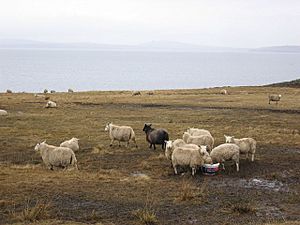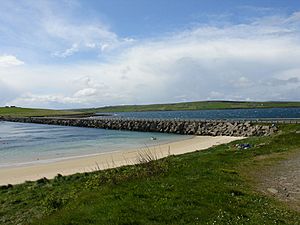Burray facts for kids
| Norse name | Borgarey |
|---|---|
| OS grid reference | ND460963 |
| Coordinates | 58°51′04″N 2°55′48″W / 58.851°N 2.93°W |
| Physical geography | |
| Island group | Orkney |
| Area | 903 hectares (3.5 sq mi) |
| Area rank | 55 |
| Highest elevation | 80 metres (262 ft) |
| Administration | |
| Sovereign state | United Kingdom |
| Country | Scotland |
| Council area | Orkney Islands |
| Demographics | |
| Population | 409 |
| Population density | 45 people/km2 |
| Largest settlement | Burray Village |
Burray is one of the Orkney Islands in Scotland. It is a small island located east of Scapa Flow. Burray is special because it is part of a chain of islands connected by the famous Churchill Barriers.
Contents
Geography and Landscape
Burray sits between two larger islands: Mainland, Orkney and South Ronaldsay. It is connected to both by the Churchill Barriers. Barriers 1, 2, and 3 link Burray to Mainland, Orkney. These barriers go across the sea, passing by the small islands of Glimps Holm and Lamb Holm. Barrier 4 connects Burray to South Ronaldsay.
To the west of Burray is Hunda, a small island you can reach by a causeway at low tide. Further west, across Scapa Flow, are the islands of Flotta and Calf of Flotta. They are about 6 kilometers (3.7 miles) away.
In 2011, about 409 people lived on Burray. The main village is Burray Village, which used to be a busy fishing port. Other small areas on the island include Northtown, Southtown, and Hillside.
The rocks on Burray are made of Old Red Sandstone. This type of rock formed millions of years ago during the Devonian period. The island has a bay called Echnaloch Bay in the northwest. You can also find two headlands, Burray Ness and Burray Haas, on the eastern side.
Things to See and Do
Burray offers some interesting places to visit. One popular spot is the Fossil and Heritage Centre at Viewforth. Here, you can learn about the island's past and see amazing Fossils found in the area.
If you enjoy nature, Burray is a good place for birdwatching. Many birds live and breed here. You might spot Eurasian curlews, herring gulls, and lesser black-backed gulls flying around.
Island History
Viking Discoveries
Long ago, in 1889, a very important Viking treasure was found on Burray. A man named Mr. G Petrie was cutting peat when he discovered it. This treasure, called a "hoard," was one of the largest ever found in Scotland.
The hoard contained over 140 silver items. Many of these were pieces of arm rings, which Vikings sometimes used as a type of money. There were also about a dozen coins. Experts believe this treasure was buried around the year 998.
Sir James Stewart's Story
In the early 1700s, a man named Sir James Stewart owned land on Burray. He was involved in a serious incident in Kirkwall in 1725. Because of this, he had to hide for twenty years.
Sir James supported the Jacobite cause. He fought in the Battle of Culloden in 1746 and was one of the few who survived. When he returned to Burray, he was recognized and arrested. Sadly, he died in a prison cell in London.
Another notable person from Burray was the writer Mary Brunton. She was born on the island in 1778.
World War II and the Churchill Barriers
The Churchill Barriers are a very important part of Burray's history. On October 14, 1939, during World War II, a German submarine sank a British battleship, HMS Royal Oak, in Scapa Flow. The submarine entered through Holm Sound, which is near Burray.
To prevent more attacks, Winston Churchill, who was in charge of the Royal Navy at the time, ordered strong barriers to be built. Work on these barriers started in May 1940. They were finished in September 1944 and officially opened in May 1945, just after the war ended.
Building the Churchill Barriers needed many workers. At its busiest, over two thousand people were involved. About 1200 of these workers were Italian prisoners of war. They had been captured in North Africa and brought to Orkney starting in 1942.
The prisoners lived in two camps. Some were at Camp 34 on Burray, and others were at Camp 60 on Lamb Holm. The prisoners at Camp 60 built the famous Italian Chapel, which is still there today. Camp 34 on Burray also had its own chapel, but it was taken down after the war. Photos show that Camp 34 even had its own football team and band!
See also
 In Spanish: Burray para niños
In Spanish: Burray para niños



